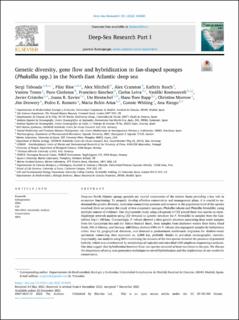| dc.contributor.author | Taboada, Sergi | |
| dc.contributor.author | Ríos, Pilar | |
| dc.contributor.author | Mitchell, Alex | |
| dc.contributor.author | Cranston, Alex | |
| dc.contributor.author | Busch, Kathrin | |
| dc.contributor.author | Tonzo, Vanina | |
| dc.contributor.author | Cárdenas, Paco A. | |
| dc.contributor.author | Sánchez, Francisco | |
| dc.contributor.author | Leiva, Carlos | |
| dc.contributor.author | Koutsouveli, Vasiliki | |
| dc.contributor.author | Cristobo, Javier | |
| dc.contributor.author | Xavier, Joana R. | |
| dc.contributor.author | Hentschel, Ute | |
| dc.contributor.author | Rapp v/dødsbo, Hans Tore | |
| dc.contributor.author | Morrow, Christine | |
| dc.contributor.author | Drewery, Jim | |
| dc.contributor.author | Romero, Pedro E. | |
| dc.contributor.author | Arias, Maria Belén | |
| dc.contributor.author | Whiting, Connie | |
| dc.contributor.author | Riesgo, Ana | |
| dc.date.accessioned | 2022-07-14T10:29:58Z | |
| dc.date.available | 2022-07-14T10:29:58Z | |
| dc.date.created | 2022-05-11T12:51:31Z | |
| dc.date.issued | 2022 | |
| dc.identifier.citation | Deep Sea Research Part I: Oceanographic Research Papers. 2022, 181 . | en_US |
| dc.identifier.issn | 0967-0637 | |
| dc.identifier.uri | https://hdl.handle.net/11250/3005380 | |
| dc.description.abstract | Deep-sea North Atlantic sponge grounds are crucial components of the marine fauna providing a key role in ecosystem functioning. To properly develop effective conservation and management plans, it is crucial to understand the genetic diversity, molecular connectivity patterns and turnover at the population level of the species involved. Here we present the study of two congeneric sponges, Phakellia robusta and Phakellia hirondellei, using multiple sources of evidence. Our phylogenetic study using a fragment of COI placed these two species as sister. Haplotype network analysis using COI revealed no genetic structure for P. hirondellei in samples from the Cantabrian Sea (<100 km). Contrastingly, P. robusta showed a clear genetic structure separating deep-water samples from the Cantabrian Sea and the Hatton-Rockall Basin, from samples from shallower waters from Kerry Head Reefs, NW of Orkney, and Norway. ddRADseq-derived SNPs for P. robusta also segregated samples by bathymetry rather than by geographical distances, and detected a predominant northwards migration for shallow-water specimens connecting sites separated ca. 2,000 km, probably thanks to prevalent oceanographic currents. Importantly, our analysis using SNPs combining the datasets of the two species revealed the presence of potential hybrids, which was corroborated by morphological (spicule) and microbial (16S amplicon sequencing) analyses. Our data suggest that hybridization between these two species occurred at least two times in the past. We discuss the importance of using next-generation techniques to unveil hybridization and the implications of our results for conservation. | en_US |
| dc.language.iso | eng | en_US |
| dc.rights | Attribution-NonCommercial-NoDerivatives 4.0 Internasjonal | * |
| dc.rights.uri | http://creativecommons.org/licenses/by-nc-nd/4.0/deed.no | * |
| dc.title | Genetic diversity, gene flow and hybridization in fan-shaped sponges (Phakellia spp.) in the North-East Atlantic deep sea | en_US |
| dc.title.alternative | Genetic diversity, gene flow and hybridization in fan-shaped sponges (Phakellia spp.) in the North-East Atlantic deep sea | en_US |
| dc.type | Peer reviewed | en_US |
| dc.type | Journal article | en_US |
| dc.description.version | publishedVersion | en_US |
| cristin.ispublished | true | |
| cristin.fulltext | original | |
| cristin.qualitycode | 1 | |
| dc.identifier.doi | 10.1016/j.dsr.2021.103685 | |
| dc.identifier.cristin | 2023511 | |
| dc.source.journal | Deep Sea Research Part I: Oceanographic Research Papers | en_US |
| dc.source.volume | 181 | en_US |
| dc.source.pagenumber | 0 | en_US |

